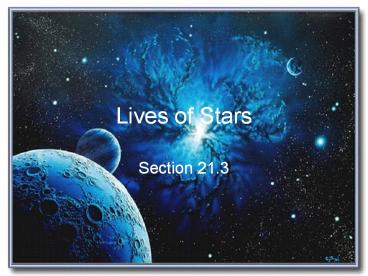Lives of Stars - PowerPoint PPT Presentation
Title:
Lives of Stars
Description:
Lives of Stars Section 21.3 Life Cycle of Stars Nebula large cloud of gas and dust spread out in an immense volume Life Cycle of Stars Gravity pulls gas and dust ... – PowerPoint PPT presentation
Number of Views:128
Avg rating:3.0/5.0
Title: Lives of Stars
1
Lives of Stars
- Section 21.3
2
- Stephen Hawking - The Birth of Stars - YouTube
3
Life Cycle of Stars
- Nebula large cloud of gas and dust spread out
in an immense volume
4
Life Cycle of Stars
- Gravity pulls gas and dust together in the
densest part of the nebula - When there
- is enough mass
- for a star to form
- it is called a
Protostar
5
Life Cycle of Stars
- When the contracting gas and dust from a nebula
becomes so dense and hot that nuclear fusion
starts, a star is born. - Dust Cloud Theory
6
Life Cycle of Stars
- How long a star lives depends on its mass
- -Stars with less mass live longer
- - Stars with more mass live shorter
- Small mass stars use up their fuel more slowly
than larger mass stars
Small stars 200 billion years Medium stars 10
billion years Larger stars 10 millions years
7
Life Cycle of Stars
- When a star begins to run out of fuel, its core
shrinks and its outer portion expands - Depending on its size, the star becomes a red
giant or a supergiant - After the fuel runs out it becomes a white dwarf,
a neutron star, or a black hole
8
Life Cycle of Stars
9
Life Cycle of Stars
10
Death of Stars
- When the fuel begins to run out of medium and
low mass stars, their outer layers expand to
become a red giant. - The outer layer then expands out in to space
(planetary nebula) and the blue-white core cools
(White Dwarf)
11
Death of Stars
- The core is very dense. A spoonful of material
would weigh as much as a truck - It would cool to become a black dwarf
Black Dwarf
White dwarf
12
Death of Stars
- Supernovas
- High mass stars evolve quickly into supergiants
- The supergiant can explode suddenly when it runs
out of fuel
13
Death of Stars
- The outer portion can form partly recycled stars
- We are made of recycled stars
- The inner portion can
- become other kinds
- of stars
Supernova
14
Death of Stars
- Neutron star
- The remains of a high mass star, smaller and
denser than white dwarfs - Spinning neutron stars (pulsars) give off pulses
of radio waves
15
Death of Stars
- Black Hole
- Form from the most massive stars when they die
- Gravity is so strong, light (or any kind of
radiation) can not escape
Black hole
16
Videos
- Black Holes, Neutron Stars, White Dwarfs, Space
and Time
17
Star Systems and Galaxies
- Binary stars
18
Star Systems and Galaxies
- Eclipsing Stars
19
Star Systems and Galaxies
- Open Cluster
20
Star Systems and Galaxies
- Globular Cluster
21
Star Systems and Galaxies
- Galaxy
22
Star Systems and Galaxies
- Spiral Galaxy
23
Star Systems and Galaxies
- Elliptical Galaxy
24
Star Systems and Galaxies
- Irregular Galaxy
25
Star Systems and Galaxies
- Quasar an enormous, distant,bright
galaxy with a black hole at its center
26
Star Systems and Galaxies
- Milky Way (our galaxy)
27
Star Systems and Galaxies
28
Star Systems and Galaxies
29
Star Systems and Galaxies
30
Star Systems and Galaxies































